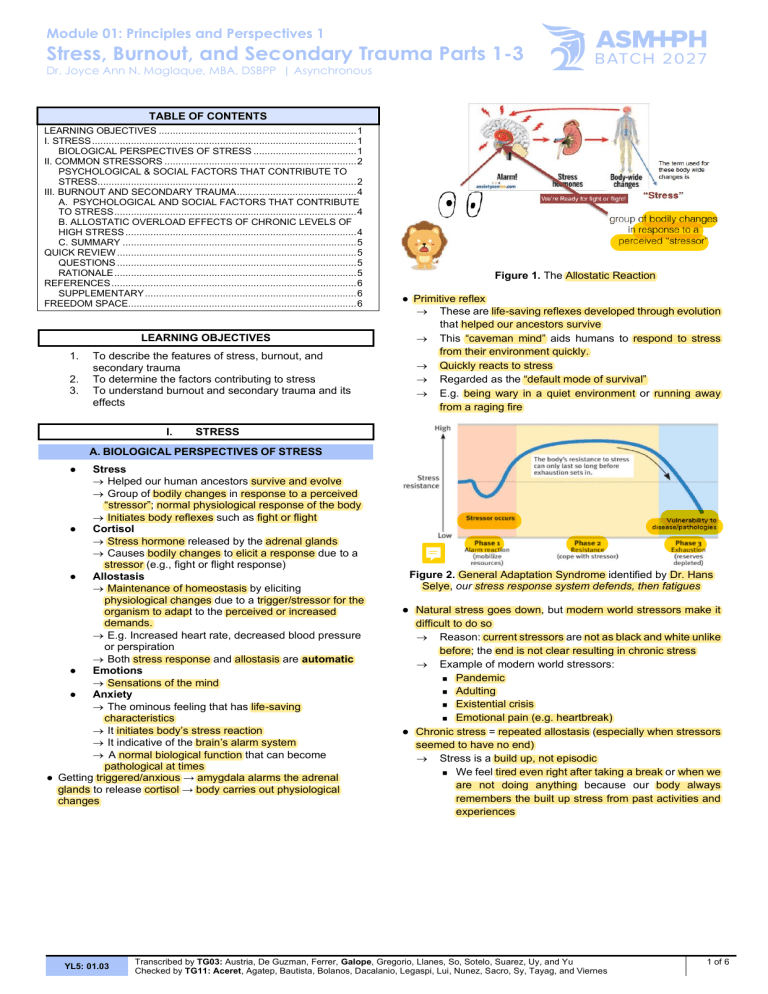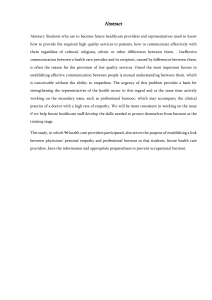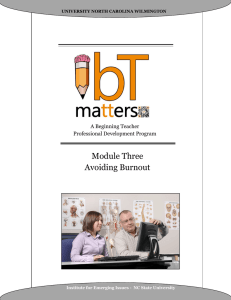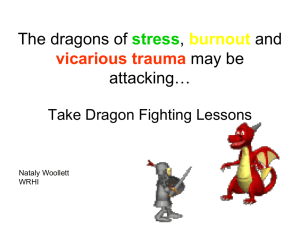
Module 01: Principles and Perspectives 1 Stress, Burnout, and Secondary Trauma Parts 1-3 Dr. Joyce Ann N. Maglaque, MBA, DSBPP | Asynchronous TABLE OF CONTENTS LEARNING OBJECTIVES ....................................................................... 1 I. STRESS ............................................................................................... 1 BIOLOGICAL PERSPECTIVES OF STRESS ..................................... 1 II. COMMON STRESSORS ..................................................................... 2 PSYCHOLOGICAL & SOCIAL FACTORS THAT CONTRIBUTE TO STRESS............................................................................................. 2 III. BURNOUT AND SECONDARY TRAUMA ........................................... 4 A. PSYCHOLOGICAL AND SOCIAL FACTORS THAT CONTRIBUTE TO STRESS ....................................................................................... 4 B. ALLOSTATIC OVERLOAD EFFECTS OF CHRONIC LEVELS OF HIGH STRESS ................................................................................... 4 C. SUMMARY .................................................................................... 5 QUICK REVIEW ...................................................................................... 5 QUESTIONS ...................................................................................... 5 RATIONALE ....................................................................................... 5 REFERENCES ........................................................................................ 6 SUPPLEMENTARY ............................................................................ 6 FREEDOM SPACE.................................................................................. 6 LEARNING OBJECTIVES 1. 2. 3. To describe the features of stress, burnout, and secondary trauma To determine the factors contributing to stress To understand burnout and secondary trauma and its effects I. Figure 1. The Allostatic Reaction ● Primitive reflex → These are life-saving reflexes developed through evolution that helped our ancestors survive → This “caveman mind” aids humans to respond to stress from their environment quickly. → Quickly reacts to stress → Regarded as the “default mode of survival” → E.g. being wary in a quiet environment or running away from a raging fire STRESS A. BIOLOGICAL PERSPECTIVES OF STRESS ● Stress → Helped our human ancestors survive and evolve → Group of bodily changes in response to a perceived “stressor”; normal physiological response of the body → Initiates body reflexes such as fight or flight ● Cortisol → Stress hormone released by the adrenal glands → Causes bodily changes to elicit a response due to a stressor (e.g., fight or flight response) ● Allostasis → Maintenance of homeostasis by eliciting physiological changes due to a trigger/stressor for the organism to adapt to the perceived or increased demands. → E.g. Increased heart rate, decreased blood pressure or perspiration → Both stress response and allostasis are automatic ● Emotions → Sensations of the mind ● Anxiety → The ominous feeling that has life-saving characteristics → It initiates body’s stress reaction → It indicative of the brain’s alarm system → A normal biological function that can become pathological at times ● Getting triggered/anxious → amygdala alarms the adrenal glands to release cortisol → body carries out physiological changes YL5: 01.03 Figure 2. General Adaptation Syndrome identified by Dr. Hans Selye, our stress response system defends, then fatigues ● Natural stress goes down, but modern world stressors make it difficult to do so → Reason: current stressors are not as black and white unlike before; the end is not clear resulting in chronic stress → Example of modern world stressors: ◼ Pandemic ◼ Adulting ◼ Existential crisis ◼ Emotional pain (e.g. heartbreak) ● Chronic stress = repeated allostasis (especially when stressors seemed to have no end) → Stress is a build up, not episodic ◼ We feel tired even right after taking a break or when we are not doing anything because our body always remembers the built up stress from past activities and experiences Transcribed by TG03: Austria, De Guzman, Ferrer, Galope, Gregorio, Llanes, So, Sotelo, Suarez, Uy, and Yu Checked by TG11: Aceret, Agatep, Bautista, Bolanos, Dacalanio, Legaspi, Lui, Nunez, Sacro, Sy, Tayag, and Viernes 1 of 6 ■ Increased BP ● As stress persists, allostatic changes continue. ALLOSTATIC CHANGES IN OUR BRAIN Figure 3. The Stress Cycle ● Resetting allostatic load is necessary → When body is pushed to limits without resetting the allostatic load, the baseline of stress response shifts → Eventually leads to a ‘point of no return’ because intervention is already necessary → Distress or burnout makes someone vulnerable to physical, emotional and cognitive changes ● Self-care is not self-indulgence → Sometimes, coping can lengthen allostasis ◼ Example of distractions or “quick fixes” as coping mechanisms − Eating − Smoking − Drinking − Shopping → Frequent indulgence will shift the allostatic load Figure 4. Baseline shift, (Left) initial basal stress reaction is steady even in mild stress; (Right) several spikes are seen even in mild stress ● Allostatic load is changed → baseline will change → mild stress will feel like a severe one already in the future SYMPTOMS OF STRESS ● Physical: → Back and shoulder stiffness and pain, headaches, stomach upset, heart palpitations, chest tightness, fast breathing, sleep problems, restlessness ● Behavior: → Drug or alcohol use, increased smoking, social withdrawal, relationship conflicts. Poor adherence to treatment regimen if with medical illness, high-risk sexual behavior ● Emotional: → Irritability, anxiety, sadness, anger, frustration, impatience, urge to cry or run and hide ● Cognitive: → Lack of focus, difficulty making decisions, low selfesteem ● Other Symptoms: → More allostatic load leads to more changes in the brain → Whenever that stressor activity is hypersensitive, this is what happens to the rest of the systems during stress: ■ Weaken the immune system, making it less able to fight off infection ■ More sensitive to pain ■ Dysregulated hormones ■ Missed menstrual periods ■ Skin and pH changes ■ Sugar metabolism dysregulation YL5: 01.03 Stress, Burnout and Secondary Trauma ● Hyper-sensitive, over stimulated amygdala → Makes you more sensitive to stress, even if it is mild → Increased anxiety reactivity → Stress becomes pathological → Ex. When someone experiences sleep deprivation for years, his brain will adapt to “the new normal” and alter his reactivity, leading to anxiety disorders and depression. ● Reduction in the size of your hippocampus → The hippocampus helps control emotions, concentration and learning → First reduces in function and then in size ● Decrease/dysregulated serotonin → Serotonin is important for neurogenesis (growth of brain cells) ■ Dysregulated serotonin leads to low neurogenesis → Promoting brain derived natural factor (BDNF) ■ BDNF ensures brain is happy, well and is doing normal function → This is associated with the pathophysiology of clinical depression and pathological anxiety Allostasis ● Physiological changes after stress help the organism to adapt to increased demands and maintain homeostasis ● These are both very important functions ● Factors that may complicate this are: → Social factors (The way we cope) → Biological factors (illnesses) ● At the end of the day, our bodies will fatigue which will lead to Allostatic overload ● Chronic stress makes you more susceptible to mental health illnesses Active Recall Box 1. Which of the following is responsible in controlling emotions, concentration and learning d. Amygdala e. Hippocampus f. Thalamus g. Hypothalamus 2. T/F. Stress is only episodic and does not buildup 3. Drug or alcohol use, increased smoking, social withdrawal, and relationship conflicts refers to what kind of stress? a. Physical b. Emotional c. Behavioral d. Cognitive Answers: 1B, 2B, 3C II. COMMON STRESSORS A. PSYCHOLOGICAL & SOCIAL FACTORS THAT CONTRIBUTE TO STRESS ● Emotional transactions matter → Emotions are important for learning → We have been socialized to “push aside” our emotions, but they are sometimes not so easily controlled ● Likening ourselves to empty glasses, → 1. As babies, we start out EMPTY 2 of 6 ■ We learn about our world through mirroring (and by the use of our mirroring neurons) ■ Mirroring proves that we are influenced by our environment → 2. INFLUENCE (first “fill” of the empty glass) ■ The first source of influence is the family, which is especially reinforced during one’s formative years ■ Influence can be introduced via implicit or explicit environmental cues → 3. BELIEFS (glass is now filled) ■ Reinforcement of influence creates beliefs → 4. IDENTITY (hand over the glass) ■ Typically occurs during teenage years (after the formative years) onwards - Beliefs can be reinforced to an adolescent via group identification (influence is external) → 5. JUDGE (stirring of the pot) ■ Refining of all accumulated influences ● Social factors that create our perception of the world are as important as the biological factors → Can be introduced both formally (e.g. schooling) and informally (e.g. interpersonal interactions) → They all get planted deep within brains and affect the way we perceive ■ Emotion (amygdala) and memory centers occupy neighboring regions of the brain ● Our perception of stress is affected by transactions → An invalidating social environment can make it very hard to regulate emotions ■ Invalidating environment = ignores emotional reactions, labeling them as invalid, weird, wrong, or bad → In formative years, the deeper comprehension area of the brain is still developing ■ Comprehension at this formative stage is in black and white ■ Ex: A grade 1 student may believe what another superior says without being aware, reinforcing whatever beliefs are forming in place ■ A child at this age may not contextually understand information - Resulting in misinterpretation and unintended reinforcement of certain beliefs ■ Some may also be subject to high levels of stress and pressure or may simply have too few resources to allocate on themselves ■ There may just be a poor fit between a person and his/her social environment → An ineffective social environment may harm one’s ability to regulate emotions and actions ■ If people give in when you get out of control, it will be difficult for you to get in control ■ If people command you to change but don’t coach you on how to do this, it will be difficult to keep on trying to change ■ Modeling of behaviors from social interactions is also possible BIO SOCIAL THEORY IN ADULTHOOD ● Bio Social Theory in Adulthood → Stress threshold / frustration tolerance ■ Stress threshold and frustration tolerance is affected by prior experiences, coping strategies, modeling, mental and physical health → Coping strategies → Mental & physical health → How we relate with life (perception) ● Adverse childhood events + biological predisposition → Trauma affects the development / sensitivity of one’s stress response ■ If one experiences trauma at an early age, their development of stress threshold and understanding of certain environmental factors is affected ● Stress threshold/frustration tolerance → coping strategies → mental & physical health → how we relate with life YL5: 01.03 Stress, Burnout and Secondary Trauma ● Stress affects how we relate with life (our perception of ourselves) → When we deal with future stressors, our affected prescriptions of ourselves will always come to mind SOCIAL FACTORS: SOURCES OF STRESS MASLOW’S HIERARCHY OF NEEDS ● Needs are not met = distress Figure no. 5 Maslow’s Hierarchy of Needs I. EXTERNAL SOURCES OF STRESS ● Tasks are never done → Demands of work, time-management problems, & worries about the past, present & future ● Multiple complex roles to fulfill/role overload → Worker, child, friend, partner, etc. → Lots of cognitive load to deal with ● Distance from family/friends ● Lack of support & conflicts in work community → Issues with peers, bullying, gossip DIGITAL FATIGUE IN COVID-19 (“ZOOM FATIGUE”) ● Tiredness worry & stress due to overusing virtual platforms of communication ● Current average screen time: 10 hours per day → Previous recommended screen time: 2 hours ● Positive association between screen time & poor mental health → Lack of perceived reward ■ Face-to-face interactions have greater activation in brain regions involved with reward → Increased cognitive effort/cost ■ Learning new platform & navigating ■ Must be more conscious on how to show listening/communication → Over-constant external self-awareness ■ Hyper-aware of your look, mannerisms, etc. → Sedentary pandemic rhythm ■ Movement = 40% reduced risk of fatigue → “Blue Light” ■ Stimulates brain = poor sleep ■ Extended exposure = strains eyes = brain in overdrive ● Many factors contribute to fatigue, not just screen time but also psychosocial factors → Work from home blurs boundaries between work and home → Extended working hours (classes not finishing on time) → Multiple responsibilities (study and home chores) ■ Same or more productivity even with a different setup → Inability of businesses/society to evolve with time ■ Stuck on PAST indicators of success ■ What makes stress stressful : CULTURE of stress = weakness, not a symptom that marks need for improvement in well-being ■ Negative judgment towards stress instead of looking why people get stressed 3 of 6 II. INTERNAL SOURCES OF STRESS ● Difference between (idealistic) expectation vs reality → Setting expectations is normal, the intention motivates us but it becomes distressing when we want it to be the reality → We tend to look at the things that are out of our control given that there are a lot of unknowns in life. ● Externalized source of validation and motivation → Internal Source of Motivation : personally drives you (ex : emotions) → Stress or fatigue that the body goes through eventually reaches a breaking point for the body BURNOUT ● Different from stress (physiological reaction) ● Nearing the edge, build up of stress ● Happens with chronic stress → External Source of Motivation : taking cues from the environment (ex : grades) ■ When sense of self is based on this, it will falter → Comparison with peers / friends / relatives ■ Normal - to look at other people as inspiration; Not good - To be like them, rather than looking at how they achieved that → Perceived lack of support or perceived pressure ■ Some of us put pressure on ourselves ■ Put pressure on someone already pressured = body will not move - Anxiety Figure 6. Cartoon depicting stress and burnout Active Recall Box 1. What is at the top of Maslow’s Hierarchy of Needs? a. Love and Belonging b. Safety and Security c. Self-Actualization 2. There is a positive association between screentime and ______ mental health a. Positive b. Poor 3. Which of the following is an External Factor of Stress? a. Distance from family/friends b. Lack of ability to go outside c. Time spent on gadgets Answers: 1C, 2B, 3A III. BURNOUT AND SECONDARY TRAUMA A. PSYCHOLOGICAL & SOCIAL FACTORS THAT CONTRIBUTE TO STRESS ● Biology is affected by our environment ● Psychology influences how we perceive our environment, and in turn influences our biology → What we have learned → Assumptions we have learned growing up ● Biology influences our psychosocial response to stress (ex: if you are sick) ● There’s a metaphor about our brain being a “Dam” → The valley is like your mind, we are able to efficiently have enough water in that mind → The water is likened to our thoughts, emotions, and actions ● With every allostatic load, that dam fatigues → As we grow older, and experience more stress the dam may fatigue → Not optimal anymore to regulate the flow of water ● Eventually it would be an overload and everything would flood in the mind → This is what we experience in burnout and secondary trauma B. ALLOSTATIC OVERLOAD: EFFECTS OF CHRONIC LEVELS OF HIGH STRESS ● Allostatic Overload → One of the theories of pathology such as the development of cancers, etc. YL5: 01.03 Stress, Burnout and Secondary Trauma ● ● ● ● ● ● ● High workload, high work Stress, high work Expectations Cynicism, Indifference Despair, Helplessness, Aversion Diminished sense of personal accomplishment Demoralization Symptoms of Poor Mental Health ● Characterized by: → Absenteeism ■ Literally being absent ■ Intentional or habitual absence at work → Presenteeism ■ There physically but checked out mentally ■ Lost productivity that occurs when employees come to work ill and perform below par The Effects of Poor Mental Health ● Burnout has been responsible for a lot of health effects ● Majority who seek consult with doctors have burnout related medical problems rather than those who have chronic illnesses Nice! • Cost associated with poor employee mental well-being is at least 2-3 times greater than direct health care expenses • In 2014, the British Economy faced a recession because of burnout ● Burnout is now a ICD diagnosis and refers as to a significant source of stress → Prequel to development of mental health problems, specifically, depression SECONDARY TRAUMA ● All kinds of helping professions and frontline responders are vulnerable to secondary traumatic stress ● May not simply hear about the trauma but also first hand witness unfolding of experiences ● HCW’s vulnerability to secondary trauma is increased when it comes with physical fatigue → Ex: when we’re exhausted it’s easy to become emotionally exhausted → HCW during pandemic → Brain and the body is connected 4 of 6 The Perils of Physician Fatigue When to Seek Help ● ● ● ● ● ● ● ● ● ● ● ● Figure 7. The Perils of Physician Fatigue Precursors to clinical depression and other mental health problems: ● Burnout → Increases suicide risk ● Compassion fatigue → Secondary trauma is a precursor to more fatigue such as compassion fatigue → Makes you less empathic with the patient → Your service suffers ● PTSD → Secondary trauma is like having symptoms of hyperarousal in PTSD ● Vicarious Trauma → Can develop from symptoms of hyperarousal in PTSD ■ Cognitively, spiritually, and being checked out of humanity ■ Disillusionment of humanity ■ Difficult to relate or trust others C. SUMMARY ● ● ● ● ● ● ● ● Stress is a normal, bodily reaction to a stimuli to help our bodies be more reactive for survival The signal that this stress reaction works is the feeling of anxiety Stress response is intrinsic in our brains and we are still using it now There are some situations in the present day that do not need further activation of stress response, but we haven't really been taught how to manage this Everytime your body reacts to a stressor, it goes through chemical changes to deal with the stimuli in an event we call: “allostasis” When allostasis is chronic and we do not get to take pauses, our bodies will overload leading to chronic changes Changes in the brain hamper the more reflective parts of our brain, leading to an “amygdala hijack” making us susceptible to → Burnout → Secondary Trauma → Mental health problems These biological changes are the body’s reaction to prolonged exposure to cortisol – it’s not PERSONAL. YL5: 01.03 Stress, Burnout and Secondary Trauma ● ● ● ● ● Increase substance (alcohol or drug) use Feeling or expressing that there is no reason for living; no sense of purpose in life Anxiety, agitation, difficulty sleeping, or sleeping all the time Feeling trapped, like there’s no way out Hopelessness Withdrawal from friends, family and society Rage, uncontrolled anger, seeking revenge Acting reckless or engaging in risky activities, seemingly without thinking Mood changes Threatening or talking about self-harm and/or suicide Looking for ways to kill oneself by seeking access to firearms, pills or other means Talking or writing about death, dying or suicide when these actions are unusual for the person Patient is severely delusional or depressed over a long time Patient has substance abuse or dependence problem Patient is suicidal Patient’s social function is seriously impaired although depressive disorder is mild Patient develops symptoms (i.e depression) while taking a particular medication QUICK REVIEW QUESTIONS 1. Cortisol is a hormone that is released by the adrenal glands. Which of the following scenario exhibits cortisol secretion a. A person performing yoga b. A person competing in a boxing match 2. All are precursors to clinical depression and other mental health problems. EXCEPT: a. PTSD b. Compassion Fatigue c. Ineffective social environment d. Vicarious Trauma 3. Taking cues from the environment is an example of an Internal source of motivation. a. True b. False 4. Christian refuses to attend important group meetings and also fails to contribute to the part assigned to him. What characteristic of burnout is Christian exhibiting? a. Presenteeism b. Absenteeism 5. An ineffective social environment can cause harm to selfregulation of emotions. Which of the following is an example of said social environment? a. Your teacher motivates you to get better grades by voluntarily enrolling you into a tutoring center. b. Two parents scold their son for coming home late. They prohibit him from going out for the next month. Answer Key 1B, 2C, 3B, 4B, 5B RATIONALE 1. B. A person competing in a boxing match – Cortisol is the primary stress hormone and is secreted at “fight or flight” situations. 2. C. Ineffective social environment – Burnout, Compassion Fatigue, PTSD, and Vicarious trauma are precursors to clinical depression that a physician experiences. 3. B. False – The type of externalized source of validation and motivation that takes cues from the environment is the External Source of Motivation. 5 of 6 4. B. Absenteeism – Christian represents the characteristic of burnout, Absenteeism, as he intentionally does not want others to feel his presence. 5. B. Two parents scold their son for coming home late. They prohibit him from going out for the next month. – This is an example of an ineffective social environment because instead of guiding their son to become better and change his attitude, they penalize him and leave him alone. REFERENCES REQUIRED I. Cee, S. (2022, August 7). Part 1 Biological Perspective of Stress [Video]. Youtube. [https://www.youtube.com/watch?v=6lOCMr5tC64] II. Cee, S. (2022, August 7). Part 2 Psychological and Social Aspects of Stress [Video]. Youtube. [https://youtu.be/EldNN4b4gW0] III. Cee, S. (2022, August 7). Part 3 Burnout, Secondary Trauma and Summary [Video]. Youtube. [https://www.youtube.com/watch?v=EldNN4b4gW0] SUPPLEMENTARY Kaplan, J.A and Weichenthal, L. (2018). Rosen's Emergency Medicine:Concepts and Clinical Practice (9th ed). Elsevier, Inc. Retrieved from https://www.clinicalkey.com.asmphlibrary.remotexs.co/#!/content/ book/3-s2.0-B9780323354790002208?scrollTo=%23hl0000089 FREEDOM SPACE YL5: 01.03 Stress, Burnout and Secondary Trauma 6 of 6



